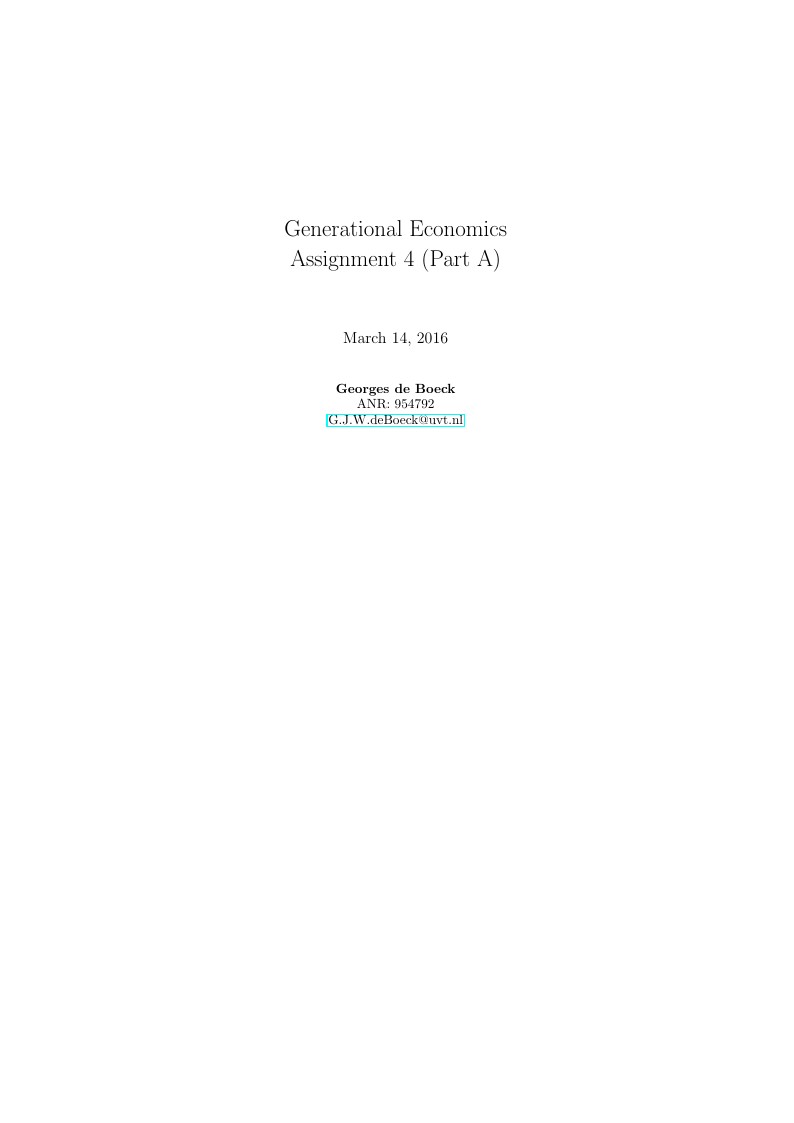
Generational Economics Assignment 4 (Part A)
Author:
Georges de Boeck
Last Updated:
10 лет назад
License:
Creative Commons CC BY 4.0
Аннотация:
Deze ding

\begin
Discover why over 20 million people worldwide trust Overleaf with their work.
Deze ding

\begin
Discover why over 20 million people worldwide trust Overleaf with their work.
\documentclass[a4paper]{article}
\usepackage[english]{babel}
\usepackage{hyperref}
\usepackage[fleqn]{amsmath}
\usepackage{array}
\renewcommand{\thesubsection}{\thesection.\alph{subsection}}
\setlength{\parindent}{0pt}
\title{Generational Economics\\
Assignment 4 (Part A)}
\begin{document}
\begin{titlepage}
\maketitle
\begin{center}
\author{
{\bf Georges de Boeck} \\
ANR: 954792\\
\href{mailto: G.J.W.deBoeck@uvt.nl}{G.J.W.deBoeck@uvt.nl}\\
}
\end{center}
\thispagestyle{empty}
\end{titlepage}
\newpage
\section{Question 1}
\textbf{Assume a standard Diamond model with given factor prices and notations as in the reader. Individuals die at the end of the first period of life with a probability $(1-\epsilon)$. There is no technological progress $(x=0)$. Expected lifetime utility is described by:
\begin{alignat}{2}
& && \hspace{0.1cm} U_t=u(c^y_t)+\frac{\epsilon}{1+\rho}u(c^o_{t+1})
\end{alignat}
Where the felicity functions $u$ are of the Constant Intertemporal Elasticity of Substitution type.}
\begin{alignat}{2}
& && \hspace{0.1cm} u(c)=\frac{c^{1-\theta}-1}{1-\theta}
\end{alignat}
\textbf{I. Derive an expression for savings per worker as a function of factor prices and parameters. Compare the result to the equation derived in the reader for the case without longevity (eq. 37) and for the case with longevity utility (eq. 63). Interpret your result.}\\\
We can use the utility function (eq. 1) and the felicity function (eq. 2) together with the budget constraints to answer this question.\\
\begin{alignat}{2}
& && \hspace{0.1cm} c^y_t=w_t-s_t \\
& && \hspace{0.1cm} c^o_{t+1}=\frac{1+r_{t+1}}{\epsilon}s_t
\end{alignat}
First we have to derive the Euler equation, by maximizing lifetime utility with respect to savings:
\begin{alignat}{2}
& && \hspace{0.1cm} {\frac{\partial U}{\partial s_t}=u'(c^y_t)\frac{\partial c^y_t}{\partial s_t}+\frac{\epsilon}{1+\rho}u'(c^0_{t+1})\frac{\partial c^o_{t+1}}{\partial s_t}=0}\\
& \Rightarrow && \hspace{0.1cm} -u'(c^y_t)+\frac{\epsilon}{1+\rho}u'(c^o_{t+1})\frac{1+r_{t+1}}{\epsilon}=0 \nonumber\\
& \Rightarrow && \hspace{0.1cm} -u'(c^y_t)+\frac{1+r_{t+1}}{1+\rho}u'(c^o_{t+1})=0 \nonumber\\
& && \hspace{0.1cm} \frac{1+r_{t+1}}{1+\rho}=\frac{u'(c^y_t)}{u'(c^o_{t+1}}
\end{alignat}
Equation 6 is the starting point, where we have to use equation 2 to get to the Euler equation.
\begin{alignat}{2}
& && \hspace{0.1cm} \frac{1+r_{t+1}}{1+\rho}=\frac{(c^y_t)^{-\theta}}{(c^o_{t+1)^{-\theta}}} \nonumber\\
& && \hspace{0.1cm} c^o_{t+1}=\frac{1+r_{t+1}}{\epsilon}s_t
\end{alignat}
\end{document}